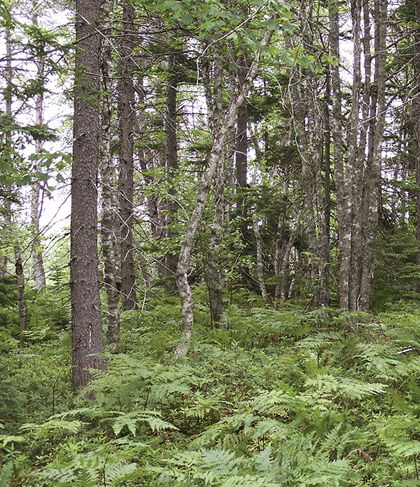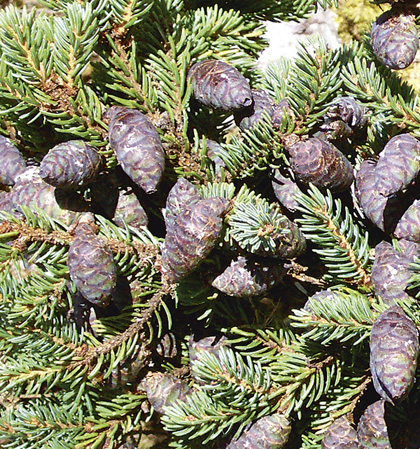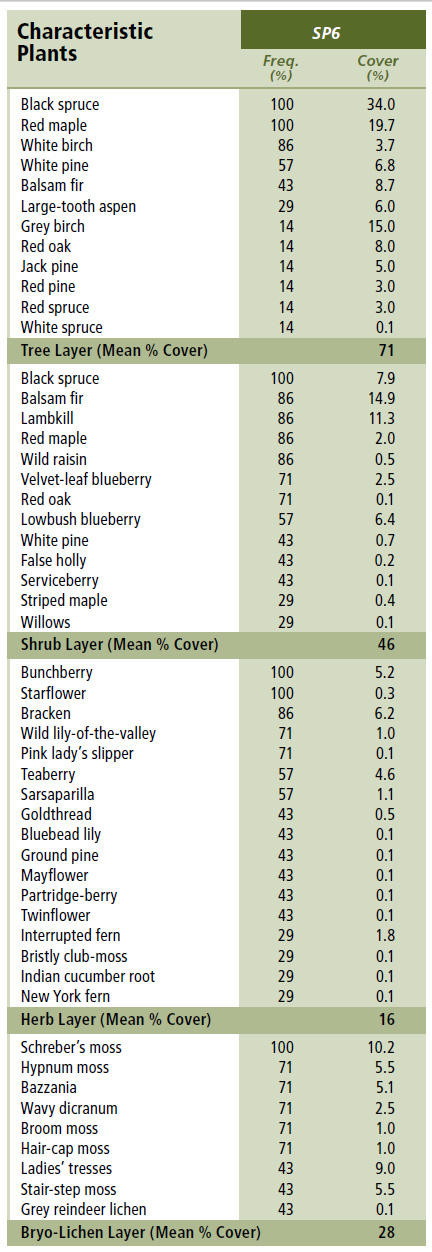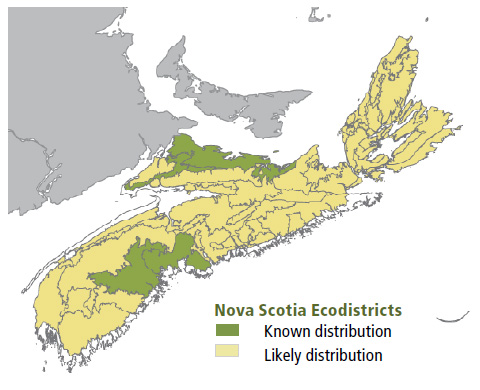
Forest Vegetation types - SP6
SP6 — Black spruce – Red maple / Bracken – Sarsaparilla
Picea mariana – Acer rubrum / Pteridium aquilinum – Aralia nudicaulis
 |
Thomson Station, Cumberland County |
Concept:This early to mid-successional Vegetation Type (VT) supports a mixedwood canopy and a relatively broad suite of herbaceous plants compared to other black spruce dominated VTs. Black spruce – Red maple / Bracken – Sarsaparilla usually follows stand-replacing disturbance events such as fire, windthrow or harvesting.
Vegetation: Black spruce is the dominant overstory tree, but red maple (with its greater potential for crown expansion) also occupies a large proportion of the canopy. White birch, balsam fir, hybrid (red/black) spruce, trembling aspen and white pine can also be found in this VT. Regenerating black spruce and balsam fir dominate the shrub layer along with wild raisin, lambkill, velvet-leaf blueberry and false holly. Bracken and bunchberry are the main species in the herb layer, but a variety of other plants can also be found including sarsaparilla, teaberry and starflower. Bryophyte coverage is generally low with leaf litter dominating the forest floor.
Environmental Setting: SP6 is associated with fresh to moist, nutrient poor soils. This VT can be found throughout Nova Scotia on a variety of soils with low nutrient status. This VT is widespread and common across the Maritime provinces.
Successional Dynamics: Nutrient poor soils and stand-replacing disturbances strongly shape both VT canopy structure and successional patterns. This generally even-aged VT usually follows stand-replacing disturbances, with harvesting the most common cause. In the absence of similar disturbance events, SP6 may succeed to a more softwood dominant stand with SP4a (White pine / Blueberry / Bracken variant Black spruce) and SP5 (Black spruce / Lambkill / Bracken) possible outcomes. SP5 is the edaphic climax for this successional pathway.
Ecological Features: This forest occurs as small to large patches in many parts of the province. It can exhibit closed or open canopies, depending on past disturbances and the degree of surface stoniness, which is often excessive in this ecosystem. Black spruce has intermediate shade tolerance and does not seed well under closed canopies; however vegetative regeneration by layering is common especially where there is a thick duff layer and adequate moisture. Dwarf mistletoe sometimes creates dense witches brooms, providing important nest and rest areas for small mammals. Mature forests develop abundant old man's beard, a lichen sought for nest material by northern parula warblers
and other species, and for winter food by deer foraging on fallen trees.
 |
| Black spruce cones |
Distinguishing Features: This softwood forest of black spruce occurs on imperfectly drained soils. Species indicative of moist soils should be present, especially sphagnum in the depressions, cinnamon fern and/or creeping snowberry. False holly and sedges are common.
| Slope Position: | Upper4 Lower3 Middle3 |
Surface Stoniness: |
(Non - Slightly)4 (Very - Excessively)4 (Moderately)2 |
Bedrock Outcrop: |
(Non-rocky)7 (Slightly - Moderately)3 |
Elevation Range: |
46 - 187m |
Slope Gradient: |
Gentle6 Moderate3 nd1 |
Aspect: |
North4 East2 West4 |
Exposure: |
Moderate10 |
Microtopography: |
Moderately7 Slightly3 Level1 |
Drainage: |
Well8 Imperfect1 Moderately well1 |
Soil Type: |
ST28 ST3-G1 ST161 |
Parent Material: |
Glacial till8 Till/Bedrock1 nd1 |
Rooting Depth (cm): |
(<30)3 (30-45)2 (>45)4 nd1 |
Duff Thickness (cm): |
(0-5)1 (6-10)5 (11-20)3 nd1 |

